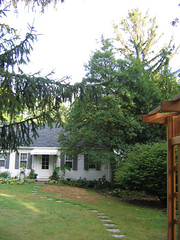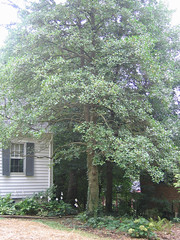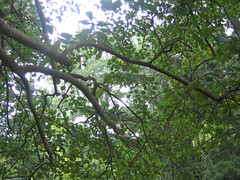Hi Ho, Holly-O
 Our house came with three mature holly trees. I haven’t a clue as to their proper names. They might be American Holly, Ilex opaca, but I’m just guessing. These behemoths are 30 feet tall, armed with the lethal leaves, and ornamented with bright red berries. (At least, the two females have berries. The male is wisely hidden along the side of the house.) Because our soil is alkaline, the leaves are usually a sickly yellow, although they’ve improved this year with the addition of Holly-Tone and peat moss. Overall, I find them ugly trees, despite the year-round foliage and ornamental berries. Like the Norway spruce, I would never have planted hollies, but I’m stuck with them.
Our house came with three mature holly trees. I haven’t a clue as to their proper names. They might be American Holly, Ilex opaca, but I’m just guessing. These behemoths are 30 feet tall, armed with the lethal leaves, and ornamented with bright red berries. (At least, the two females have berries. The male is wisely hidden along the side of the house.) Because our soil is alkaline, the leaves are usually a sickly yellow, although they’ve improved this year with the addition of Holly-Tone and peat moss. Overall, I find them ugly trees, despite the year-round foliage and ornamental berries. Like the Norway spruce, I would never have planted hollies, but I’m stuck with them. Last fall, Mike and I spread the neighbors’ leaves along our side yard, beneath two of the hollies and our burning bush, at a depth of about eight inches. The leaves effectively smothered the patchy grass and my shade garden extension was born.
Last fall, Mike and I spread the neighbors’ leaves along our side yard, beneath two of the hollies and our burning bush, at a depth of about eight inches. The leaves effectively smothered the patchy grass and my shade garden extension was born.As I’ve gardened beneath the hollies, I’ve come to appreciate them for the wonderful quality of shade they provide. The canopy is not dense, so the shade is dappled, providing perfect conditions for most shade plants. When the wind blows and the small holly leaves are tossed, the resulting light patterns remind me of being underwater. It’s all very restful until I kneel down to pull a weed and am poked in the knee by a sharp holly leaf.
Unlike the Norway spruce, the hollies’ roots are easy to garden above. They dive fairly deep into the soil, but when encountered, are easy to dig and plant around. Except for my pouty hydrangea, the holly and my shade plants do not seem to compete for moisture.
 From beneath, the branches are revealed to fabulously contorted. It’s as if the world’s spinning has confused the growing tips into lurching in random directions. The result is artful, if difficult to fit into a yard waste bag after trimming the tree.
From beneath, the branches are revealed to fabulously contorted. It’s as if the world’s spinning has confused the growing tips into lurching in random directions. The result is artful, if difficult to fit into a yard waste bag after trimming the tree.I still find the hollies ugly when studied from afar, but I’m enchanted once I’m beneath their spread. In most other yards, the hollies’ branches extend down the trunk to ground level, creating an impenetrable cone. Those homeowners don’t know the magical world they’re missing beneath the holly boughs.


3 Comments:
And ever tried walking barefoot around one of the damn things? Or picking up fallen leaves barehanded. Boy, hollies must really hate us. Susan
When I moved in there were two 4-foot hollies on the side of the garage, pruned into ball shapes. I've been trying to convince one of them that's it's okay to be a tree, and like you, am seeing that other plants are okay under the dappled shade.
But the points penetrate even leather gloves! I've noticed that if a windstorm comes when leaves are new and still soft, they puncture holes in each other, too.
Annie
Iused to live in Louisville and had two huge American Hollies out front. Using very thick leather gloves, I managed to prune them and have lots of Christmas decorations. The robins used to perch on them in spring and eat every single berry (and leave lots of poop on the front steps!) It was a real love/hate relationship with them. On the positive side, my friend had a wonderful old holly in her back yard that spread dappled light over her garden and plants loved it!
Post a Comment
<< Home